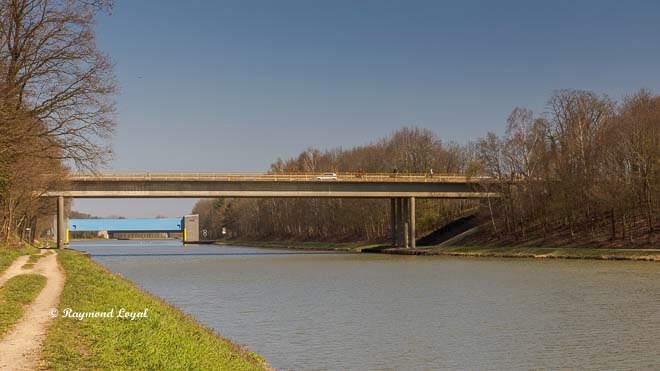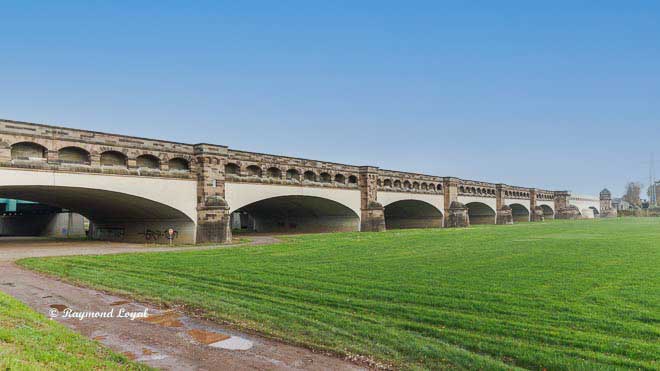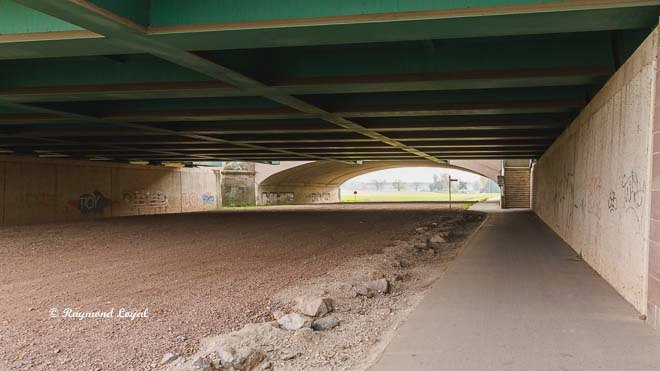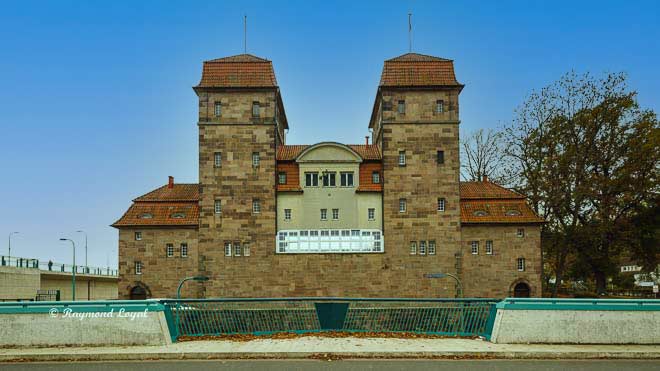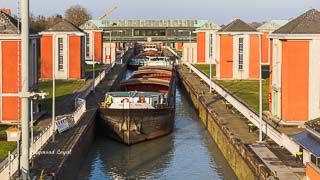Mittelland Canal - Midland Canal
The Mittelland Canal (German = Mittellandkanal) also known as Midland Canal is a German inland waterways connecting the waterways networks of Belgium and The Netherlands as well as the waterways networks in central Germany and in the west of Poland. Other connections are to Switzerland, Czech Republik, Slowakia, Hungary, Serbia, Romania and Bulgaria. As such the Midland Canal is the most important canal in Europe and longest of its kind in Germany.
The Midland Canal runs over a length of 323.50 kilometres beginning at Dortmund-Ems Canal, shortly after the town of Bergeshövede and ending at the passage into the Elbe-Havel Canal at Hohenwarthe in the German state of Sachsen-Anhalt.
European Waterways - Editorial on the Midland Canal - Information and Photography
This editorial is set to follow the run of the canal from its beginning at Bergeshövede up to its end at the locks of Hohenwarthe in the German state of Sachsen-Anhalt.


Locks in the Midland Canal (MLK)
How many lock systems are in the Midland Canal? There are only three lock systems directly within the course of Midland Canal. All other lock systems connected to Midland Canal are the junctions to rhe rivers Weser, Leine and Elbe and to the Elbe Lateral Canal with its branch canals und another 12 locks. In all the Midland Canal only accounts for 15 lock systems which is relatively low compared to Dortmund-Ems Canal. However Midland Canal runs through lowlands over long distances without any significant gradients.
Three large lock systems are necessary to overcome large fall heights:
- Anderten Locks (double shaft lock system) at canal kilometre 174.238
- Sülfeld Locks (North and South lock chamber) at canal kilometre 236.76 and 236.98
- Hohenwarthe Locks at canal kilometre 324.46
Waterways Crossings within Midland Canal
Not only impresses Midland Canal by its sheer length but also because of the number of waterways crossings in the canal from start to end. In its course Midland Canal crosses three river, which are Weser, Leine and Elbe. The waterways crossings are:
- Waterways Triangle Hörstel (the beginning of Midland Canal)
- Waterways Crossing Minden(crossing the river Weser in two trough bridges) begins at km 101,56
- Waterways Crossing Seelze (Hanover-Seelze - crossing the river Leine in two trough bridges) - main bridge at km 252, flood bridge at km 152,10
- Waterways Crossing Magdeburg Rothensee (crossing the river Elbe in a trough bridge), begins in the west at km 320,45 drop of 11-18 metres
- Waterways Crossing Hohenwarthe - The end of Midland Canal and connection to Elbe-Havel-Canal at km 324,46 (double locks)
Branch Channels connecting to Midland Canal (MLK)
How many branch channels connect to Midland Canal? In fact, and compared to the length of the canal, we are talking only six branch canale which are (canal abbreviation in brackets):
- Ibbenbühren branch canal (SKM) - length from km 0.00 to km 1.11 - entrance south banks
- Osnabrück branch canal (SKO) - length from km 0.04 to km 14.53 - entrance south banks
- Hannover-Linden branch canal (SKL) - length fom km 0.26 to km 11,20 - entrance south banks
- Misburg branch canal (SKM) - length from km 0.35 to km 3.40 - entrance north banks
- Hildesheim branch canal (SKH) - length from km 0.03 to km 15.12 - entrance west banks
- Salzgitter branch canal (SKS) - length from km 0.03 to km 17.96 - entrance south banks
- Branch-off Elbe Lateral Canal (Elbe-Seitenkanal) at km 233,65 - entrance north banks
Midland Canal (MLK) connections to rivers Weser, Leine and Elbe
Midland Canal connects to the rivers Weser, Leine and Elbe. At the rivers Weser and Elbe the canal crosses the rivers on massive trough bridges. In order to allow barges to descend to the deeper rivers connection channels were built:
- Connection Channel North connecting to river Weser (VKN) branching off MLK at kilometre 101.56 - Shaft Locks Minden - Weser Locks Minden
- Connecton Channel South connecting to river Weser (VKS) branching off MLK at kilometre 102.93
- Connection Channel to river Leine (VKL) junction off Hannover Branch Canal at Hannover-Linden at kilometre 8.46
- Connection Channel Rothensee (RVK) - connecting to river Elbe, branching off at MLK kilometre 319.894
Inland Harbours alongside Midland Canal
Midland Canal runs through the German states of North Rhine-Westphalia, Lower Saxony and Saxony Anhalt (Sachsen-Anhalt). There are 25 inland harbours along the course of the canal which make a significant contribution to the economy. The harbours are listed below:
- Harbour Ibbenbühren - North Rhine-Westphalia
- Harbour Reke - North Rhine-Westphalia
- Osnabrück Harbour - Lower Saxony
- Bramsche Harbour - Lower Saxony
- Harbour Bad Essen - Lower Saxony
- Getmold Harbour - North Rhine-Westphalia
- Lübbecke Harbour - North Rhine-Westphalia
- Ille Harbour - North Rhine-Westphalia
- Minden Harbour - North Rhine-Westphalia
- Bückeburg Harbour - Lower Saxony
- Niederwöhren Harbour - Lower Saxony
- Sachsenhagen Harbour - Lower Saxony
- Wunstorf Harbour - Lower Saxony
- Seelze Harbour - Lower Saxony
- Harbour Hanover - Lower Saxony
- Sehnde Harbour - Lower Saxony
- Hildesheim Harbour - Lower Saxony
- Mehrum Harbour - Lower Saxony
- Peine Harbour - Lower Saxony
- Harbour Braunschweig - Lower Saxony
- Wolfsburg Harbour - Lower Saxony
- Flechtlingen Harbour - Saxony Anhalt
- Haldersleben Harbour - Saxony Anhalt
- Vahldorf Harbour - Saxony Anhalt
- Harbour Magdeburg - Saxony Anhalt
The Beginning of Midland Canal
Midland canal begins near the township of Bergeshövede, in Tecklenburger Land, by branching off Dortmund-Ems-Canal at canal kilometre 108.36.
Waterways Crossing Minden in the Midland Canal
About 2.5 km north to Minden City centre there is one of the largest waterways crossings in Germany and the largest in the German state of Northrhine Westphalia, the waterways crossing Minden which connects Midland Canal with the river Weser. Two large trough bridges cross the Weser river 13 meters above normal water level. Though what is easy reading here is in fact technical master works.
The first trough bridge to cross the river Weser was built as part of the construction of Midland Canal. As mentioned before the trough bridge itself was a technical masterworks of its own, especially back in 1911 when the canal was still being built. It took the engineers 33 months to complete the bridge work alone. Building works on the bridge started in 1911 and on May 25 1914 water was filled into the canal and the trough bridge for the first time. The old trough bridge measures 370 in length and the trough is 24 meters across with a depth of 3 metres. Two arches of the bridge cross the river Weser, each arch with a clear width of 50 metres.
Extension works on Midland canal in the 1990s also required a larger trough bridge and from October 1993 a second bridge was built directly beside the old bridge. The new bridge was to be a completely modern design and was constructed from steal elements which were assembled on site creating a canal trough of 341 metres of length and 42 metres across and a depth of 4 metres. The larger construction became necessary because the modern much larger barges simply required more space in the canal. With the new bridge oncoming traffic in the waterways crossings now became possible. After a construction time of nearly 5 years the new trough bridge was opened to traffic.
The old trough bridge is still connected to Midland Canal but only sport boats are allowed to use the bridge. All freight barges have to use the new bridge.



Connection Channel North to the River Weser (VKN)
The connection channel north connects Midland Canal with the river Weser which is also the shortest way between canal and river. A substantial height difference of 13.20 metres between the Weser river level and the canal is overcome by two large canal locks. The canal measures a length of 1290 metres between the upper outer harbour and the lower outer harbour where the canal flows into the river Weser. The old Minden Shaft Locks was built in 1914 when the first construction phase of Midland Canal was completed at Minden.
Shaft Locks Minden in the Connection Channel North (VKN)
Shaft Locks Minden was built between 1911 and 1914 and with a chamber length of 85 metres with 10 metres across it was the right size for the barges at that time. Because channels do not produce any own water but are dependend on water coming from the rivers, lakes and reservoirs it was necessary to minimise the water usage for every lock passage as low as was techniqually possible. In order to achieve that aim eight water basins on four levels were installed on each side of the locks, totalling 16 water basins to manage the lock passages.
For Downstream or descending passages for ships and barges coming out of Midland Canal heading for the river Weser, about 7,300 m³ of water are pumped into the economising basins and about 4,000 m³ are drained into the Weser. With ships and barges using the upstream passage, coming from the river Weser and heading for destinations along Midland Canal, the economising basins are emptied into the lock chamber and about 4,000 m³ of water are drained from Midland Canal into the locks chamber.
Depending on Weser river levels the drop between canal and river can reach a maximum of 13.20 metres. The upstream floodgates are built as drop gate while the downstream gate is a vertical lift gate.
Parts of the locks can be visited against a small entrance fee and can watch the lock chamber from above. Tickets can be bought at the ticket machine close the the visitor's turnstile. Because of Corona there are no opening times available.
Weser Locks Minden
The traffic increas in inland navigaton required the construction of much larger barges bringen the old shaft locks at Minden to its limits. Nowadays modern large motor barges measures 110 metres in length and compound formations even measure a length of 139 metres. In order to secure the connection to the seaports of Bremen (DEBRE) and Bremerhaven (DEBRV) a new lock chamber was needed in the connection channel north, because that channel was the fastest and cheapest connection to the river Weser.
The expansion work on Midland Canal also made larger locks necessary and plans were made for a second locks in the Connection Channel North. The new "Weserschleuse Minden" was to be built directly beside the old shaft locks. Construction works begun in the spring of 2010 and the new locks were opened to traffic on August 18th 2017, after a construction time of seven years. Similar to the old locks, Weserschleuse Minden was bild as an economising locks; directly besides the locks, on the eastern side, there are three economising basins of which two are built in two levels one above each other.
The new Weserschleuse Minden has an effective chamber length of 139 metres,a width of 12.50 metres and a threshold depth of 4 metres to accommodate large motor barges and push compounds, with the centre distance between the two locks standing at 52 metres. Depending on Weser river levels, the maximum drop between canal and river can reach 13.30 metres. The downstream floodgates are constructed as a folded plate design (German = Stemmtor) which opens to the inside whereas the upstream gate is designed as a Tainter gate or drop gate. Such Tainter or drop gates, when opened, are simply dropped below the water surface and when fully opened the gate closes with the locks threshold. Water usage doubles the amount of the old shaft locks.
Connection Channel South to the River Weser (VKS)
The second to option to descent to and ascent from the river Weser is the connection channel south abbreviated to VKS, also called southern descent. The channel brances off Midland Canal at canal kilometre 102,93 and sits on the wester side of the waterways crossing and on the western banks of the river Weser. In total the channel measures 1.33 km in length and meets with the Weser and river kilometre 204.47. Built as a grid locks system the channel consists of an upper locks at the channel side and a lower locks at the river side; the long stretch between the locks was built to equalize water levels in the channel.
The upstream locks overcomes a drop of 6.30 metres, with the chamber measuring 82 metres in length and 10 metres across. Entrance to the locks is at channel kilometre 0.16. After the locks are the entrances to basin I and II of Minden harbour.
The downstream locks begins at channel kilometre 1.2 with a chamber length of 82 metres and already a width of 12.50 metres, although, this locks was build only after World War II. Because of the bottle neck at the upstream locks, the grid locks system is no longer sufficient for modern inland navigation.
Anderten Locks in Midland Canal
Coming from the west the first locks directly situated in Midland Canal is Anderten Locks in Hanover, widely known as Hindenburgschleuse Anderten, in the Hanover district of Anderten. The locks sits directly on the so-called summit reach of the canal and therefore, directly between the western reach, marking the section between the wet triangle and Anderten and the eastern reach, marking the stretch between Anderten and the end of the canal near Hohenwarthe. Situated on an exact north-south axis the locks overcome a drop of 4.70 metres between the northern lower reach and the upper reach in the south; the locks sit at canal kilometre 174.24.
Construction works began as early as 1923 and after five years where finally opened to traffice on June 20th 1928, by the then President of State. Because of the difficult water supply situtation at the summit reach, it was a necessity to construct an economising lock system. No less than 50 economising basins were built to achieve that goal. During each passage the basins are either filled with water or emptied into the lock chambers. Effective water usage during each passage stands at 9,828 m³.
The double locks system at Hanover Anderten consists of the western and the eastern chamber which have the same measures:
Chamber Length: 225.00 m
Effective length: 214.00 m
Chamber Width: 12.00 m
Effective Width: 11.60 m
Threshold depth: 3.50 m
Real fairway depth: 4.00 m
Headroom Downstream Head West: 5.50 m
Headroom Downstram Head East: 6.60 m
Headroom Upstream Head: 5.90 m
Volume Chambers: 39,798 m³ cubic metres
Real Water Usage per passage: 9,828 m³ cubic metres
Drop: 14.70 m
Downstream Head Gates: Lift Gate
Upstream Head Gates: Drop Gate
Address:
Hindenburgschleuse Anderten
An der Schleuse
D-30559 Hannover
Opening Times: daily 24/7

